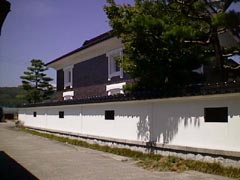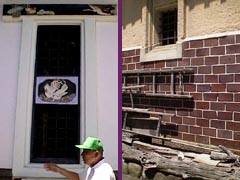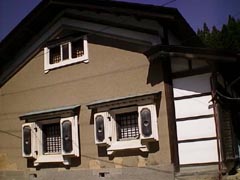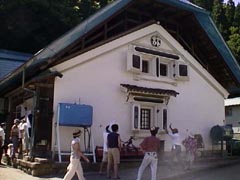
|

|
|
August 8, 1999. A tour of the "kura" storehouse. Kitakata City, Fukushima Prefecture. A small newspaper article led me to take a trip to see the "kura" storehouses in Kitakata. Heading down the Tsuchiyu Pass through the Hibara scenic highway from the Ura Bandai toll road, I arrived at the village of Kura in an hour and a half. This travel event, in its 5th year, sells out right away. The "kura" in Kitakawa is used everywhere in daily life. Even new structures are built in the "kura" style to harmonize with the sights. I heard that the reason there are so many "kuras" in Kitakata is because the "kuras" remained unburned in the disasterous fire of 1877. Please visit Kitakata. It is a town with a human touch with pure water and air. |

Plaster walls that match the "kura" enclose the grounds each house. |

Left) It is a prosperous village that produces Aizu rice. All homes have a great "kura". This is a "kura" with a "kote drawing" of a rooster, pine tree, and crane. Right) The double burned brick is a distinctive feature of Kitakata "kuras". |
|||

A farmer's "kura" in the cedar mountain. There is never the same roof, window, or door. I wonder if it is the ambitiousness in each household? |

A part of a "kura" house, the "magariya" or L-shaped "kura", has two adjoining rooms. |

|